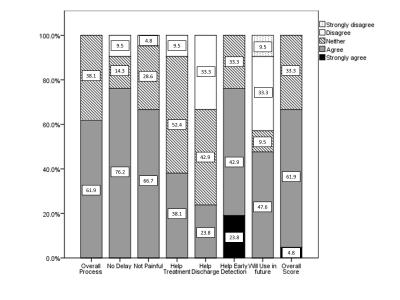|
Basic Research - Neurourology & LUTS/BPH & Others(구연)
|
(E-041)
|
|
|
비뇨기과적 수술 후 도뇨관 제거전 방광내 주입술의 환자 만족도에 대한 전향적 연구 |
| 분당서울대학교병원 비뇨기과 |
| 송상헌, 노진, 이학민 |
Purpose
To evaluate safety and patient-clinician satisfaction of retrograde bladder filling method prior to catheter removal after urological surgery.
Materials and Methods
Male patients undergoing transurethral prostatectomy (TURP) for benign prostatic hyperplasia (BPH) from January 2019 to October 2019 were randomized into either retrograde filling or spontaneous voiding methods. Perioperative outcomes and complications were assessed, and satisfaction with either technique was assessed with questionnaires for the patient as well as the clinician (nurse or physician) involved in removing the foley catheter. Time to void and time to discharge was compared to assess facilitation of discharge.
Results
54 men were randomized into two groups, 28 men in retrograde filling and 26 in spontaneous voiding. There was no significant difference in baseline characteristics including preoperative prostate volume or uroflowmetry Qmax. Retrograde filling significantly facilitated time to void (67±63.2 min vs 144 ± 78.7; p=0.001) and time to discharge (168.4±57.2 vs. 218.9±106.9; p=0.046). Overall patient satisfaction was not different in both groups (35.68±5.0 vs. 34.12±4.71; p=0.244), and 61.9% of clinicians were satisfied with the overall process. Immediate postoperative Clavien-Dindo grade≥3 complication and reintervention within a 3 month follow-up were comparable in both methods with no significant difference (35% vs. 23.1%, p=0.150; 21% vs. 15.4%, p=0.568, respectively).
Conclusion
Retrograde fill method for catheter removal is a safe and satisfactory method that can facilitate early voiding detection and time to discharge. Large scale trials are required to further validate our results.
|
 |
|
keywords : Retrograde bladder filling, foley catheter removal, patient satisfaction |
|

